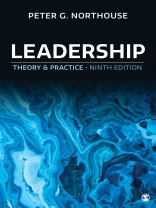Adopted at more than 1, 600 institutions in 89 countries and translated into 15 different languages!
The market-leading
Leadership: Theory and Practice by Peter G. Northouse presents an academically robust account of the major theories and models of leadership with a focus on how theory can inform practice. Northouse uses a consistent structure for each chapter that allows readers to easily compare and contrast different theories. Case studies and questionnaires provide students with practical examples and opportunities to deepen their understanding of their own leadership style. The fully updated
Ninth Edition features a new chapter on inclusive leadership, 17 new real-world cases that profile leaders from across the globe, a new discussion on leadership and morality, and examples of timely issues such as leadership during the COVID-19 pandemic.
This title is accompanied by a complete teaching and learning package.
Mục lục
PREFACE
ACKNOWLEDGMENTS
ABOUT THE AUTHOR
ABOUT THE CONTRIBUTORS
CHAPTER 1. Introduction
LEADERSHIP DEFINED
LEADERSHIP DESCRIBED
PLAN OF THE BOOK
SUMMARY
CHAPTER 2. Trait Approach
DESCRIPTION
HOW DOES THE TRAIT APPROACH WORK?
STRENGTHS
CRITICISMS
APPLICATION
SUMMARY
CHAPTER 3. Skills Approach
DESCRIPTION
HOW DOES THE SKILLS APPROACH WORK?
STRENGTHS
CRITICISMS
APPLICATION
SUMMARY
CHAPTER 4. Behavioral Approach
DESCRIPTION
HOW DOES THE BEHAVIORAL APPROACH WORK?
STRENGTHS
CRITICISMS
APPLICATION
SUMMARY
CHAPTER 5. Situational Approach
DESCRIPTION
HOW DOES SLII® WORK?
STRENGTHS
CRITICISMS
APPLICATION
SUMMARY
CHAPTER 6. Path–Goal Theory
DESCRIPTION
HOW DOES PATH–GOAL THEORY WORK?
STRENGTHS
CRITICISMS
APPLICATION
SUMMARY
CHAPTER 7. Leader–Member Exchange Theory
DESCRIPTION
HOW DOES LMX THEORY WORK?
STRENGTHS
CRITICISMS
APPLICATION
SUMMARY
CHAPTER 8. Transformational Leadership
DESCRIPTION
HOW DOES THE TRANSFORMATIONAL LEADERSHIP APPROACH WORK?
STRENGTHS
CRITICISMS
APPLICATION
SUMMARY
CHAPTER 9. Authentic Leadership
DESCRIPTION
HOW DOES AUTHENTIC LEADERSHIP WORK?
STRENGTHS
CRITICISMS
APPLICATION
SUMMARY
CHAPTER 10. Servant Leadership
DESCRIPTION
MODEL OF SERVANT LEADERSHIP
HOW DOES SERVANT LEADERSHIP WORK?
STRENGTHS
CRITICISMS
APPLICATION
SUMMARY
CHAPTER 11. Adaptive Leadership
DESCRIPTION
A MODEL OF ADAPTIVE LEADERSHIP
HOW DOES ADAPTIVE LEADERSHIP WORK?
STRENGTHS
CRITICISMS
APPLICATION
SUMMARY
CHAPTER 12. Inclusive Leadership
DESCRIPTION
A MODEL OF INCLUSIVE LEADERSHIP
HOW DOES INCLUSIVE LEADERSHIP WORK?
STRENGTHS
CRITICISMS
APPLICATION
SUMMARY
CHAPTER 13. Followership
DESCRIPTION
THEORETICAL APPROACHES TO FOLLOWERSHIP
HOW DOES FOLLOWERSHIP WORK?
STRENGTHS
CRITICISMS
APPLICATION
SUMMARY
CHAPTER 14. Gender and Leadership
DESCRIPTION
GENDER DIFFERENCES IN LEADERSHIP STYLES AND EFFECTIVENESS
STRENGTHS
CRITICISMS
APPLICATION
SUMMARY
CHAPTER 15. Leadership Ethics
DESCRIPTION
STRENGTHS
CRITICISMS
APPLICATION
SUMMARY
CHAPTER 16. Team Leadership
DESCRIPTION
HOW DOES THE TEAM LEADERSHIP MODEL WORK?
STRENGTHS
CRITICISMS
APPLICATION
SUMMARY
REFERENCES
AUTHOR INDEX
SUBJECT INDEX
Giới thiệu về tác giả
Peter G. Northouse, Ph D, is Professor Emeritus of Communication in the School of Communication at Western Michigan University. Leadership: Theory and Practice is the best-selling academic textbook on leadership in the world and has been translated into 15 languages. In addition to authoring publications in professional journals, he is the author of Introduction to Leadership: Concepts and Practice (now in its sixth edition) and co-author of Leadership Case Studies in Education (now in its fourth edition) and Health Communication: Strategies for Health Professionals (now in its third edition). His scholarly and curricular interests include models of leadership, leadership assessment, ethical leadership, and leadership and group dynamics. For more than 40 years, he has taught courses in leadership, interpersonal communication, and organizational communication on both the undergraduate and graduate levels. Currently, he is a consultant and lecturer on trends in leadership research, leadership development, and leadership education. He holds a doctorate in speech communication from the University of Denver, and master’s and bachelor’s degrees in communication education from Michigan State University.












